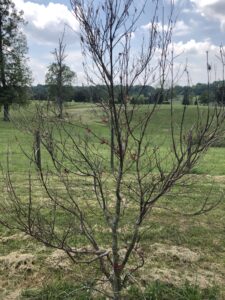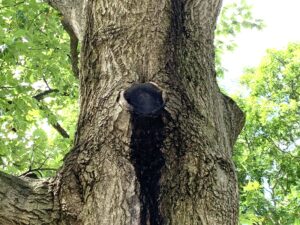Q: Our Japanese red maple tree was full of new leaves when the hard freeze hit. It is just now getting a few leaves again. Should I trim the tree back, or just wait and see what happens? I do not know how much is dead or how much will produce new growth. – A.K., Harrison County
A: It’s easy to check the twigs for live tissue. If twigs appear to be dead, scrape away the outer bark and look for green tissue underneath, an indication that there is still hope for regrowth. Also, check for the presence of buds, which should also be green in color when cut open.
Dead plant twigs generally will break clean when bent; live twigs should still be somewhat flexible.Dead twigs and branches can be removed any time of year, but the rest of your pruning on this tree should wait until late winter or early spring next year. More information on pruning at https://www.extension.purdue.edu/extmedia/HO/HO-4-W.pdf.
Q:About 18 months ago, my 30-year-old oak tree started weeping a liquid about 15 feet up on one side. A couple of branches way above it appeared to die off. The rest of the tree seemed OK. Later the backside seemed to crack in several places and a liquid flow down the tree. However, the leaves way up remained green and fell in the fall as usual along with huge numbers of acorns. Now almost two years later several cracks have appeared where the liquid flowed, but leaf buds are appearing all over the tree.
It is a huge tree about 14 inches in diameter. Could it have recovered? Is it still in danger? Last summer two small branches grew on this lower part of the tree! The tree is on the front of my residence and provides great shade. I would hate to see it go. Also, it probably would cost nearly $1,000 to remove. J.M., Valparaiso
A: It sounds like your tree may have a condition called slime flux, which is usually associated with wounds or other damage to the trunk. It is usually not fatal to the tree on its own, but it can be indicating other damage has occurred. The Purdue Landscape Report recently published an article on this subject. https://www.purduelandscapereport.org/article/slime-flux-of-trees/. The dead branches should be removed taking care to avoid injury to the trunk.
If there is significant damage, you may want to contact a certified arborist to assess whether the tree might be a safety risk. Purdue Landscape Report recently covered this topic as well. https://www.purduelandscapereport.org/article/how-to-identify-tree-defects-and-what-to-do-about-it/.

